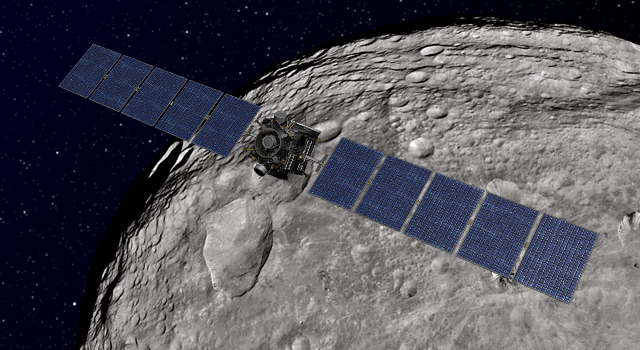Highs and Lows of Exploring the Giant Asteroid
Friday, March 2nd, 2012
As NASA’s Dawn spacecraft investigates its first target, the giant asteroid Vesta, Marc Rayman, Dawn’s chief engineer, shares a monthly update on the mission’s progress.

This artist’s concept shows NASA’s Dawn spacecraft orbiting the giant asteroid Vesta. The depiction of Vesta is based on images obtained by Dawn’s framing cameras. Image credit: NASA/JPL-Caltech |
› Full image and caption
Dear Ups and Dawns,
Dawn is continuing its exploits at Vesta, performing detailed studies of the colossal asteroid from its low altitude mapping orbit (LAMO). The robotic ambassador is operating extremely well on behalf of the creatures it represents on a distant planet. On this second intercalary day of its ambitious adventure, the spacecraft is doing exactly what it was designed to do: exploring a previously uncharted alien world.
Although we usually describe LAMO as being at an average altitude of 210 kilometers (130 miles), that does not mean it is at a constant altitude. As we saw on the fourth anniversary of Dawn’s departure from Earth, there are two reasons the spacecraft’s height changes. One is that the elevation of the surface itself changes, so if the probe flew in a perfect circle around Vesta, its altitude would vary according to the topography. Like the planet from which Dawn embarked upon its deep space journey in 2007 (and even some of the residents there), Vesta is broadest near its equator, and that is where the ground generally reaches its greatest distance from the center. In addition, the ancient surface, battered over billions of years in the rough and tumble of the asteroid belt, displays remarkable variations in shape. The giant Rheasilvia basin is a scar from an extraordinary impact that excavated a region encompassing the south pole more than 500 kilometers (over 300 miles) in diameter. This immense gouge has left that part of Vesta at a much lower elevation than elsewhere. In the center of the enormous depression is the second tallest mountain known in the solar system, soaring to well over twice the height of Mt. Everest. The vertical range from the highest locations near the equator to the bottoms of the deepest craters within Rheasilvia is more than 60 kilometers (37 miles). So as Dawn loops around in just over four hours, the surface underneath it rises and falls dramatically.
The second reason is that the orbit itself is not exactly a circle. Let’s ignore for a moment the effect of the topography and focus solely on the shape of the craft’s path around Vesta. As Vesta rotates and Dawn revolves, the gravitational forces acting on the orbiter are always changing because of the irregular distribution of material inside the geologically complex protoplanet. This effect occurred at the higher altitudes as well, but it was much less pronounced there. Now that the adventurer is deep in the gravity field, the peaks and valleys of its own motion are magnified.
Navigators were very careful in choosing the parameters for LAMO, recognizing that the orbital waters were turbulent. Nevertheless, their mapping of the gravitational currents proved quite accurate, and the spacecraft has followed the planned course quite well. The lengthy and relatively technical discussions in the two previous logs described why the ship drifts off a little, but operators occasionally nudge it back with the ion propulsion system.
Orbits usually are best described by ellipses, like flattened circles. Now Vesta’s bumpy gravity field does not allow perfectly smooth, regular orbits at low altitude. Moreover, the variations in the strength of the gravitational attraction transform the orbits. Sometimes, the difference between the high point of a loop and the low point is less than 16 kilometers (10 miles). As the changing forces reshape the orbit, the ellipse gets more exaggerated, with the low points going lower and the high points going higher. The differences within one revolution grow to be more than 75 kilometers (47 miles). Thanks to the ingenious design of the orbital trajectory however, those same forces then will gradually attenuate the profile, causing it to become more round again. This pattern repeats every 11.5 days in LAMO. It is almost as if the orbit breathes slowly, its envelope expanding and contracting.





















